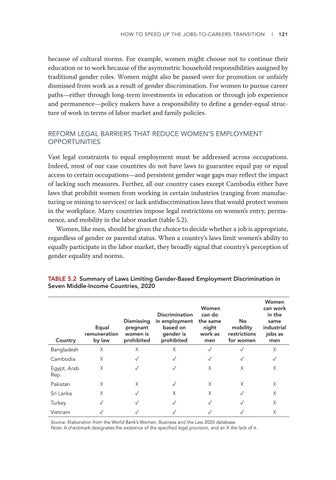How to Speed Up the Jobs-to-Careers Transition
l
121
because of cultural norms. For example, women might choose not to continue their education or to work because of the asymmetric household responsibilities assigned by traditional gender roles. Women might also be passed over for promotion or unfairly dismissed from work as a result of gender discrimination. For women to pursue career paths—either through long-term investments in education or through job experience and permanence—policy makers have a responsibility to define a gender-equal structure of work in terms of labor market and family policies. REFORM LEGAL BARRIERS THAT REDUCE WOMEN’S EMPLOYMENT OPPORTUNITIES Vast legal constraints to equal employment must be addressed across occupations. Indeed, most of our case countries do not have laws to guarantee equal pay or equal access to certain occupations—and persistent gender wage gaps may reflect the impact of lacking such measures. Further, all our country cases except Cambodia either have laws that prohibit women from working in certain industries (ranging from manufacturing or mining to services) or lack antidiscrimination laws that would protect women in the workplace. Many countries impose legal restrictions on women’s entry, permanence, and mobility in the labor market (table 5.2). Women, like men, should be given the choice to decide whether a job is appropriate, regardless of gender or parental status. When a country’s laws limit women’s ability to equally participate in the labor market, they broadly signal that country’s perception of gender equality and norms. TABLE 5.2 Summary of Laws Limiting Gender-Based Employment Discrimination in Seven Middle-Income Countries, 2020
No mobility restrictions for women
Women can work in the same industrial jobs as men
Country
Equal remuneration by law
Dismissing pregnant women is prohibited
Discrimination in employment based on gender is prohibited
Women can do the same night work as men
Bangladesh
☓
☓
☓
✓
✓
☓
Cambodia
☓
✓
✓
✓
✓
✓
Egypt, Arab Rep.
☓
✓
✓
☓
☓
☓
Pakistan
☓
☓
✓
☓
☓
☓
Sri Lanka
☓
✓
☓
☓
✓
☓
Turkey
✓
✓
✓
✓
✓
☓
Vietnam
✓
✓
✓
✓
✓
☓
Source: Elaboration from the World Bank’s Women, Business and the Law 2020 database. Note: A checkmark designates the existence of the specified legal provision, and an X the lack of it.


